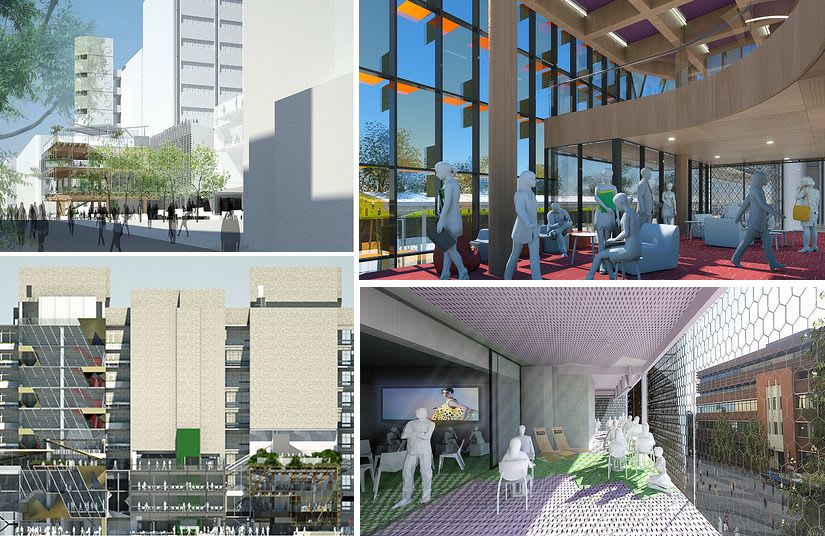RMIT rolls out a heightened student experience
Head into Melbourne's CBD via Swanston Street and you're met with a relic of a bygone era: RMIT University's Buildings 10, 12 and 14. Constructed during the 1970's the insular edifice has received little more than cosmetic work since, with the promise of extensive design changes looming over the complex in recent years.
Last week it was announced the quartet (including the more recent Building 8) would receive an extensive upgrade with the aim of creating a contemporary learning environment equal to its modern sibling, the Swanston Academic Building. This will be achieved by enlivening the lower levels across the buildings, essentially creating interconnected learning and social spaces, outdoor terraces and laneways; with natural light prominent to most areas.
No less that five architecture firms have been engaged to create an outcome dubbed New Academic Street which will exemplify the following design characteristics:
- Consolidate the University library and create more space there for students.
- Improve the way students can access services.
- Make it easier and safer to move through the buildings.
- Create more space and better facilities for schools.
- Provide better options for buying food and drink.
- Reduce energy consumption.
- Cut the cost of maintenance.
The Swanston Library, which attracts up to 9,600 students a day, will be completely refurbished to provide more than 40 per cent more quiet and collaborative study spaces which will include light-filled areas looking onto Bowen Street.
Students arriving on campus will be able to converge on the new level 4 Student Hall and connect with services directly or via a single step referral to a specialist provider.
RMIT University
While final designs on the horizon and works are expected to commence next year, Maddison Architects have released a number of images online which will constitute Building 14's upgrade. Included within Building 14 is a new retail strip over level 4 which will deliver a cluster of commercial, recreational and food outlets in addition to licensed bar, suggesting the precinct will be a hub of activity beyond the standard tertiary calendar.
This exciting (and complex) project involves the renovation and addition to multiple RMIT buildings along Swanston Street. Maddison Architects are working with Lyons, MVS, NMBW and HAW architects to deliver a major building upgrade and dynamic new interaction between the university campus and the surrounding city streets. Maddison Architects are currently working on Building 14 (Bowen Street).
Maddison Architects
The Urban Square adds to the mix
Recently serving as a storage zone and workers facilities area during construction of the Swanston Academic Building, RMIT have elected to provide a temporary urban square for students and public alike on a vast piece of land on Stewart Street and A'Beckett Street.
RMIT University’s A’Beckett Urban Square, designed by Peter Elliott Architecture + Urban Design, is the latest addition to this collection of mercurial urban interventions. Described by the university as an ‘urban sport and recreational pop-up’, this $1.2 million project has turned a former car park into a publicly accessible, 2800-square-metre park incorporating sports courts, landscaping, BBQ facilities, table tennis, WiFi and bike parking.
“It needed to be a place that was active and engaged – it’s a place for casual recreation,” says Peter Elliott. “It’s really meant for active ball games, because there’s really almost nowhere in the city you can do that, apart from what RMIT already has in its campus on Bowen Street.”
ArchitectureAU
Comment
Passing through the area, the Urban Square has already become popular with the basketball courts in particular seemingly always in use.
The one negative looks to be Stewart Street which is caught in no man's land: it serves no primary purpose. No through auto traffic renders it useless as a street and RMIT's SAB doesn't open up to Stewart Street well enough to facilitate further foot traffic.
With whatever form RMIT's future Urban Square building will take along with the influx of thousands of apartments in the area, it looks a decent opportunity for RMIT and City of Melbourne to collaborate on transforming Stewart Street into a viable, enjoyable urban space. Banish on street parking (3 parking spaces won't demonstrably diminish council revenue), allow only loading vehicle in via a single lane and the remainder with a green space.
An easy solution, but the opportunity for more to be done exists. For mine based on current foot and vehicle flows plus future intentions, the eventual transformation of Stewart Street is a monte.
Further reading
- RMIT image gallery: New Academic Street
- ArchitectureAU: Parking space to play space
- Urban Square design: Peter Elliott Architects
